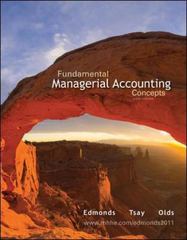Question
(1.) An investor, who had $75,000 to contribute, was choosing between a boutique and a local shoe shop. After careful deliberation, the investor chose the
(1.) An investor, who had $75,000 to contribute, was choosing between a boutique and a local shoe shop. After careful deliberation, the investor chose the boutique.
In the first year, the boutique generated enough profit to pay the investor $15,000 (an agreed percentage of profits to be paid to the investor). The investor found out that if he had invested in the local shoe shop he would have received $9,000 (an agreed percentage of profits to be paid to the investor).
The investor's economic profit was __________.
- a.)
- $24,000
- b.)
- $51,000
- c.)
- $15,000
- d.)
- $6,000
(2.) Rent control is a type of __________ that lowers the price of rent below market value. This creates a __________of affordable apartments, as more people want apartments at this price, and fewer landlords are willing and able to offer them.
- a.)
- price floor; shortage
- b.)
- price ceiling; producer surplus
- c.)
- price floor; producer surplus
- d.)
- price ceiling; shortage
(3.) Robertoften complained about theprice of liquor but still purchased a bottle of wine every week.
Which of the following statements is true?
- a.)
- The high taxes failed to modify consumer behavior.
- b.)
- The government experienced a deadweight loss because of the tax.
- c.)
- The consumer demand at this price point is relatively elastic.
- d.)
- The tax would result in a lower revenue for the government.
(4.) If the number of building permits for new housing increase, economists predict that __________.
- a.)
- consumer demand for several markets will decrease
- b.)
- jobless claims will increase now and in the future
- c.)
- consumer demand for several markets will increase
- d.)
- demand for loans will decrease
(5.) Which of the following is not true about the indicator consumer credit?
- a.)
- It is lagging because it can take people a while to borrow money in response to a changing economy.
- b.)
- It measures small, everyday purchases made by consumers.
- c.)
- It estimates changes in the amount of loans that consumers have.
- d.)
- It looks at interest rates in various industries for different kinds of loans.
(6.) Economists use the Consumer Confidence Index to view __________.
- a.)
- whether interest rates will rise or fall
- b.)
- production levels by firms
- c.)
- the relationship between tax revenue and tax rates
- d.)
- decisions about household spending and saving
Step by Step Solution
There are 3 Steps involved in it
Step: 1

Get Instant Access to Expert-Tailored Solutions
See step-by-step solutions with expert insights and AI powered tools for academic success
Step: 2

Step: 3

Ace Your Homework with AI
Get the answers you need in no time with our AI-driven, step-by-step assistance
Get Started


